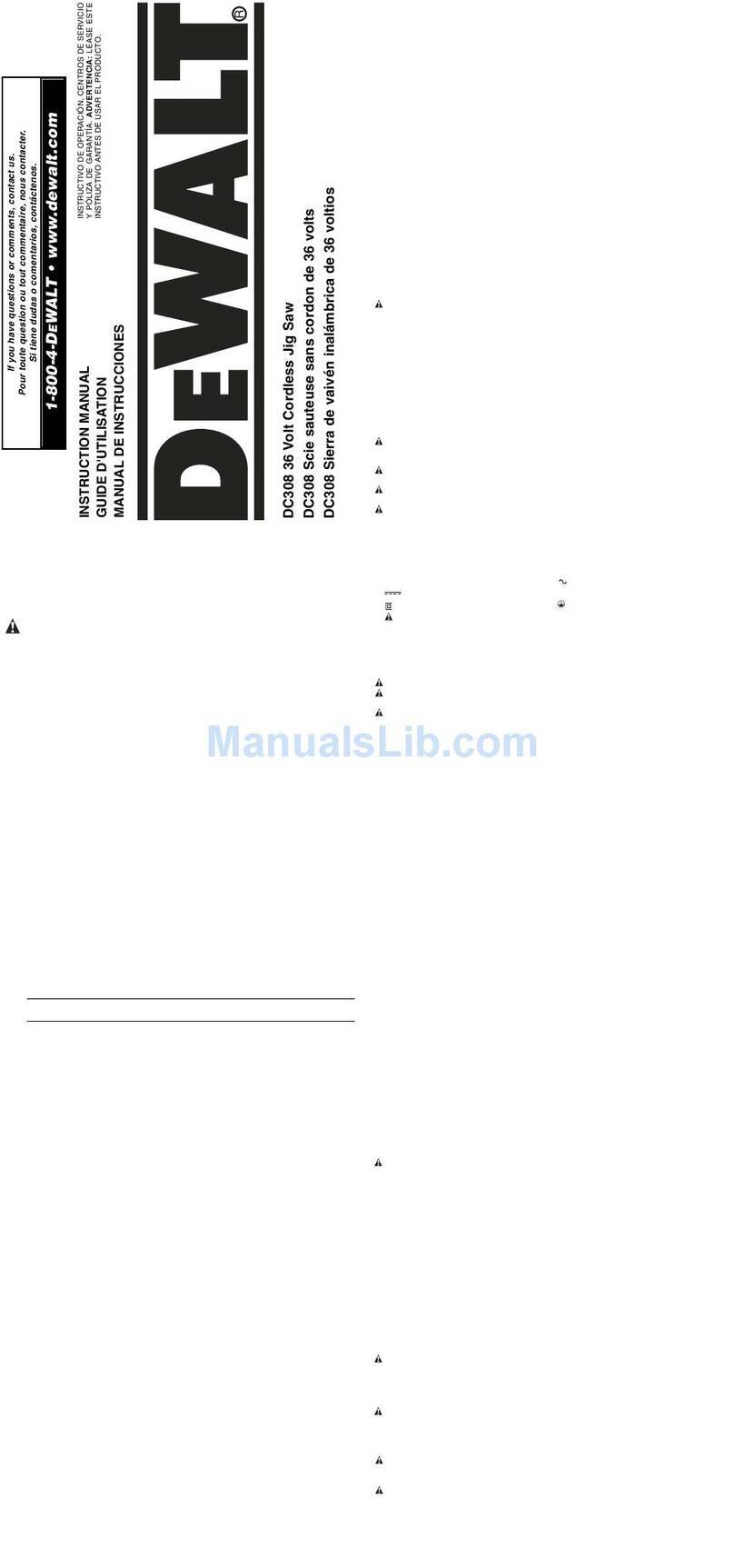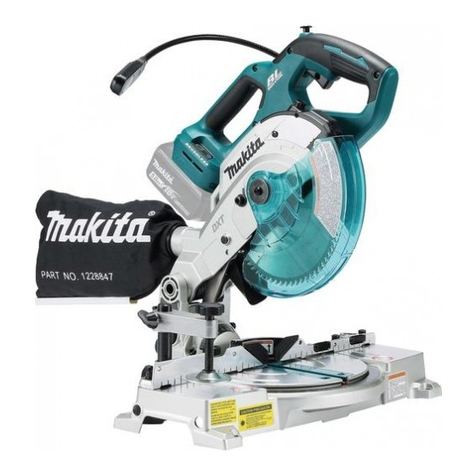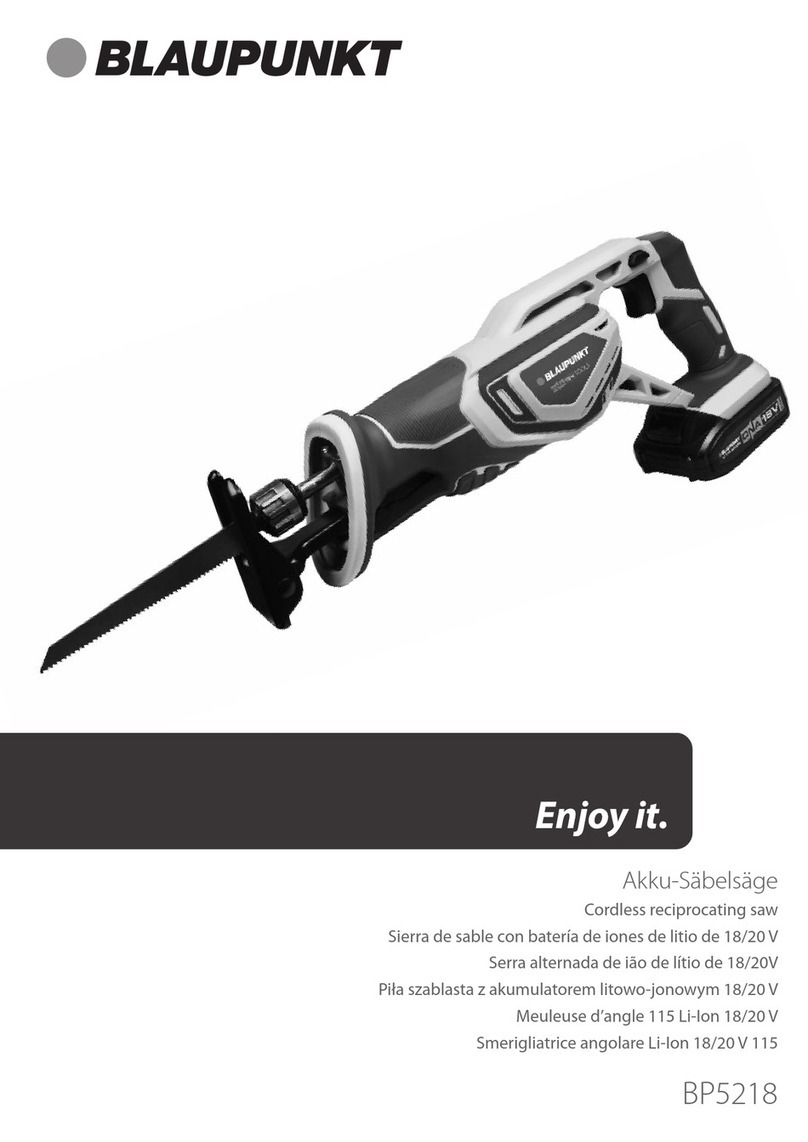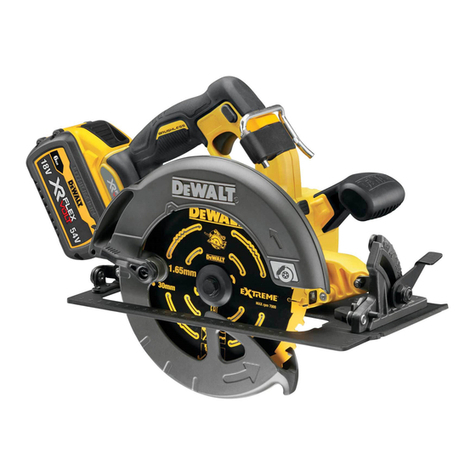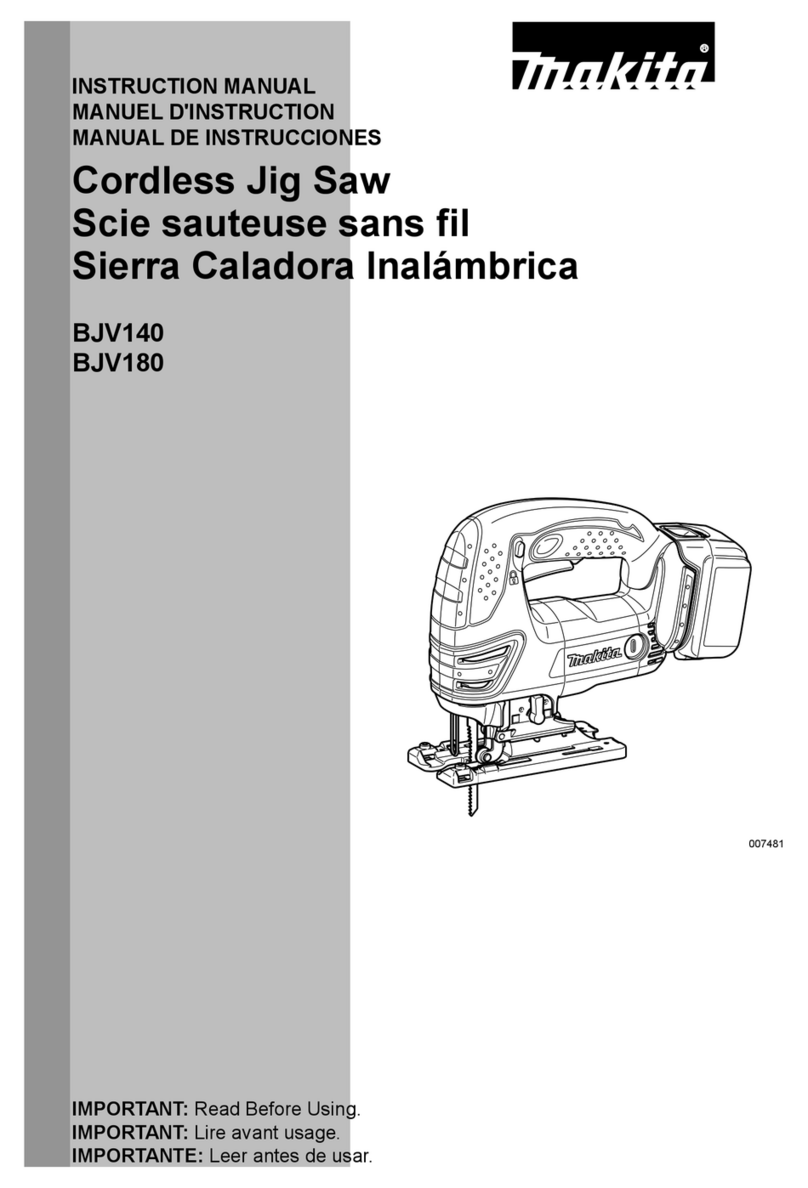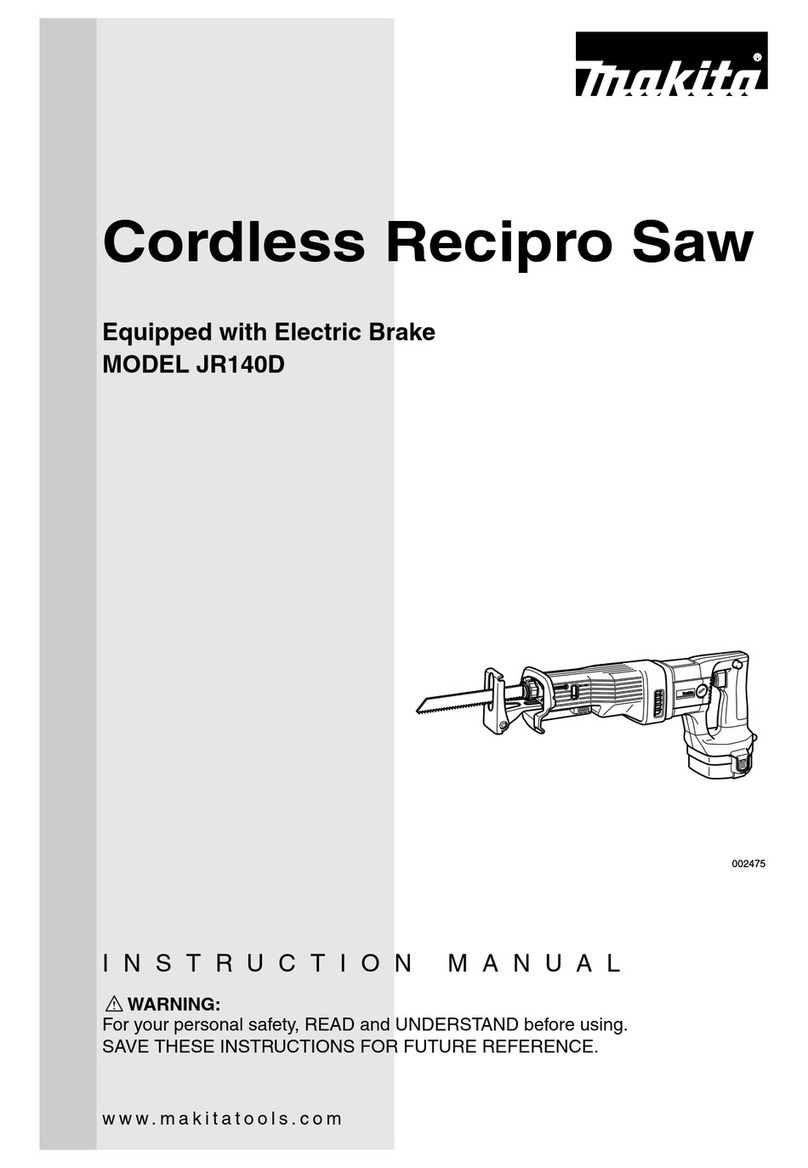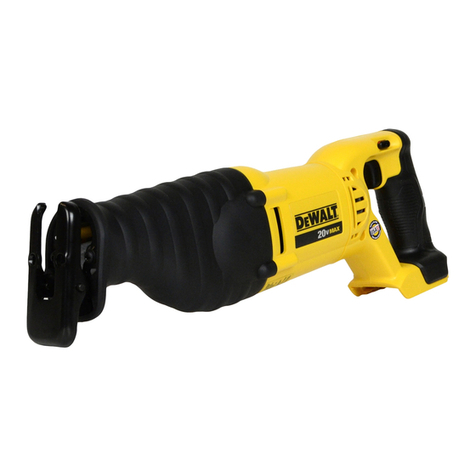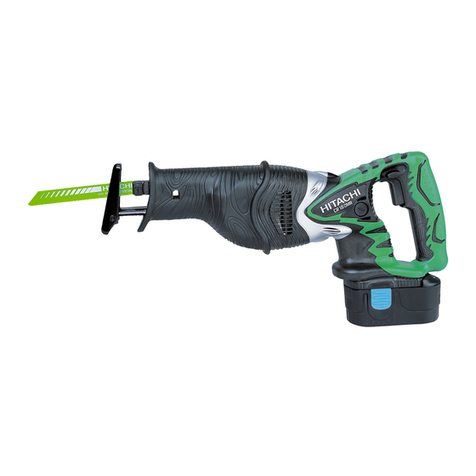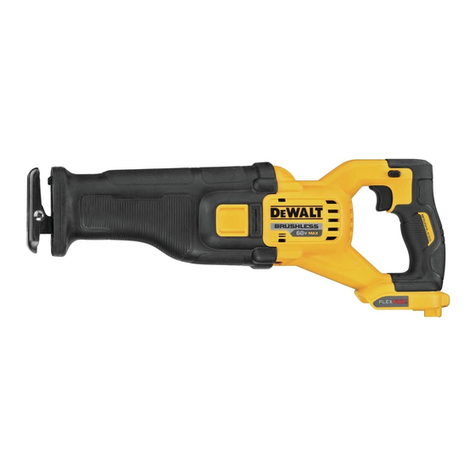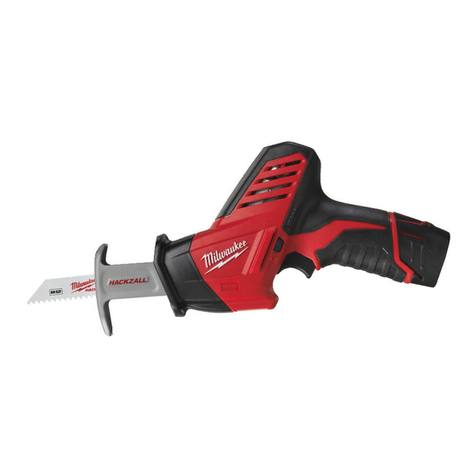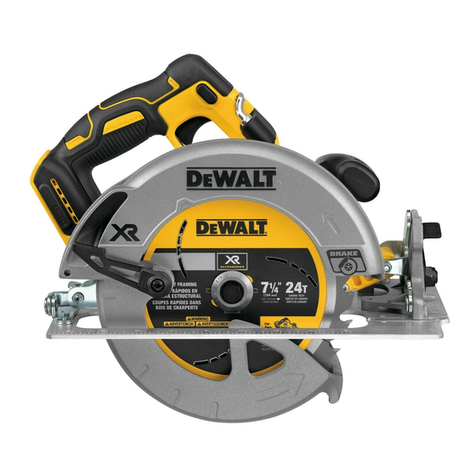Feider FSC20V165 User manual

ORIGINAL
INSTRUCTIONS
Instruction
Manual
Cordless Circular
Saw
Model
FSC20V165
CAUTION: READ THIS INSTRUCTION MANUAL BEFORE USE THIS MACHINE

BUILDER SAS
32, rue Aristide Bergès - ZI 31270 Cugnaux –France
MADE IN PRC 2019

1. SAFETY INSTRUCTIONS
WARNING Read all safety warnings and all instructions. Failure to follow the warnings
and instructions may result in electric shock, fire and/or serious injury.
Save all warnings and instructions for future reference. The term "power tool" in the warnings
refers to your mains-operated (corded) power tool or battery-operated(cordless) power tool.
1) Work area safety
a) Keep work area clean and well lit. Cluttered or dark areas invite accidents.
b) Do not operate power tools in explosive atmospheres, such as in the presence of
flammable liquids, gases or dust. Power tools create sparks which may ignite the dust or fumes.
c) Keep children and bystanders away while operating a power tool. Distractions can cause
you to lose control.
2) Electrical safety
a) Power tool plugs must match the outlet. Never modify the plug in any way. Do not use
any adapter plugs with earthed (grounded) power tools. Unmodified plugs and matching
outlets will reduce risk of electric shock.
b) Avoid body contact with earthed or grounded surfaces, such as pipes, radiators, ranges
and refrigerators. There is an increased risk of electric shock if your body is earthed or grounded.
c) Do not expose power tools to rain or wet conditions. Water entering a power tool will
increase the risk of electric shock.
d) Do not abuse the cord. Never use the cord for carrying, pulling or unplugging the power
tool. Keep cord away from heat, oil, sharp edges or moving parts. Damaged or entangled
cords increase the risk of electric shock.
e) When operating a power tool outdoors, use an extension cord suitable for outdoor use.
Use of a cord suitable for outdoor use reduces the risk of electric shock.
f) If operating a power tool in a damp location is unavoidable, use a residual current device
(RCD) protected supply. Use of an RCD reduces the risk of electric shock.
NOTE the term “residual current device (RCD)”may be replaced by the term “ground fault circuit
interrupter (GFCI)” or “earth leakage circuit breaker (ELCB)”.
3) Personal safety
a) Stay alert, watch what you are doing and use common sense when operating a power
tool. Do not use a power tool while you are tired or under the influence of drugs, alcohol or
medication. A moment of inattention while operating power tools may result in serious personal
injury.
b) Use personal protective equipment. Always wear eye protection. Protective equipment
such as dust mask, non-skid safety shoes, hard hat, or hearing protection used for appropriate
conditions will reduce personal injuries.
c) Prevent unintentional starting. Ensure the switch is in the off-position connecting to
power source and/or battery pack, picking up or carrying the tool. Carrying power tools with
your finger on the switch or energizing power tools that have the switch on invites accidents.
d) Remove any adjusting key or wrench before turning the power tool on. A wrench or a key
left attached to a rotating part of the power tool may result in personal injury.
e) Do not overreach. Keep proper footing and balance at all times. This enables better control
of the power tool in unexpected situations.

f) Dress properly. Do not wear loose clothing or jeweler. Keep your hair, clothing and gloves
away from moving parts. Loose clothes, jeweler or long hair can be caught in moving parts.
g) If devices are provided for the connection of dust extraction and collection facilities,
ensure these are connected and properly used. Use of dust collection can reduce dust-related
hazards.
4) Power tool use and care
a) Do not force the power tool. Use the correct power tool for your application. The correct
power tool will do the job better and safer at the rate for which it was designed.
b) Do not use the power tool if the switch does not turn it on and off. Any power tool that
cannot be controlled with the switch is dangerous and must be repaired.
c) Disconnect the plug from the power source and/or the battery pack from the power tool
before making any adjustments, changing accessories, or storing power tools. Such
preventive safety measures reduce the risk of starting the power tool accidentally.
d) Store idle power tools out of the reach of children and do not allow persons unfamiliar

with the power tool or these instructions to operate the power tool. Power tools are
dangerous in the hands of untrained users.
e) Maintain power tools. Check for misalignment or binding of moving parts, breakage of
parts and any other condition that may affect the power tool’s operation. If damaged, have
the power tool repaired before use. Many accidents are caused by poorly maintained power
tools.
f) Keep cutting tools sharp and clean. Properly maintained cutting tools with sharp cutting edges
are less likely to bind and are easier to control.
g) Use the power tool, accessories and tool bits etc. in accordance with these instructions,
taking into account the working conditions and the work to be performed. Use of the power
tool for operations different from those intended could result in a hazardous situation.
5) Battery tool use and care
a) Recharge only with the charger specified by the manufacturer. A charger that is suitable for
one type of battery pack may create a risk of fire when used with another battery pack.
b) Use power tools only with specifically designated battery packs. Use of any other battery
packs may create a risk of injury and fire.
c) When battery pack is not in use, keep it away from other metal objects, like paper lips,
coins, keys, nails, screws or other small metal objects, that can make a connection from
one terminal to another. Shorting the battery terminals together may cause burns or a fire.
d) Under abusive conditions, liquid may be ejected from the battery; avoid contact. If
contact accidentally occurs, flush with water. If liquid contacts eyes, additionally seek
medical help. Liquid ejected from the battery may cause irritation or burns.
6) Service
a) Have your power tool serviced by a qualified repair person using only identical
replacement parts. This will ensure that the safety of the power tool is maintained.
SPECIFIC SAFETY RULES
DANGER:
a) Keep hands away from cutting area and blade. Keep your second hand on auxiliary
handle or motor housing. If both hands are holding the saw, they cannot be cut by the blade.
b) Do not reach underneath the workpiece. The guard cannot protect you from the blade below
the workpiece.
c) Adjust the cutting depth to the thickness of the workpiece. Less than a full tooth of the
blade teeth should be visible below the workpiece.
d) Never hold piece being cut in your hands or across your leg. Secure the workpiece to a
stable platform. It is important to support the work properly to minimize body exposure, blade
binding, or loss of control.
e) Hold power tool by insulated gripping surfaces when performing an operation where the
cutting tool may contact hidden wiring or its own cord. Contact with a “live” wire will also make
exposed metal parts of the power tool “live” and shock the operator.
f) When ripping always use a rip fence or straight edge guide. This improves the accuracy of
cut and reduces the chance of blade binding.
g) Always use blades with correct size and shape (diamond versus round) of arbor holes.
Blades that do not match the mounting hardware of the saw will run eccentrically, causing loss of
control.

h) Never use damaged or incorrect blade washers or bolt. The blade washers and bolt were
specially designed for your saw, for optimum performance and safety of operation.
Special safety regulations
Causes and operator prevention of kickback:
- Kickback is a sudden reaction to a pinched, bound or misaligned saw blade, causing an
uncontrolled saw to lift up and out of the workpiece toward the operator;
- When the blade is pinched or bound tightly by the kerf closing down, the blade stalls and the
motor reaction drives the unit rapidly back toward the operator;
- If the blade becomes twisted or misaligned in the cut, the teeth at the back edge of the blade can
dig into the top surface of the wood causing the blade to climb out of the kerf and jump back toward
the operator.
Kickback is the result of saw misuse and/or in corrects operating procedures or conditions and can
be avoided by taking proper precautions as given below.

a) Maintain a firm grip with both hands on the saw and position your arms to resist
kickback forces. Position your body to either side of the blade, but not in line with
the blade. Kick back could cause the saw to jump backwards, but kickback forces can be
controlled by the operator, if proper precautions are taken.
b) When blade is binding, or when interruptiing a cut for any reason, release the trigger
and hold the saw motionless in the material until the blade comes to a complete
stop. Never attempt to remove the saw from the work or pull the saw backward
while the blade is in motion or kickback may occur. Investigate and take corrective
actions to eliminate the cause of blade binding.
c) When restarting a saw in the workpiece, center the saw blade in the kerf and check
that saw teeth are not engaged into the material. If saw blade is binding, it may walk
up or kickback from the workpiece as the saw is restarted.
d) Support large panels to minimize the risk of blade pinching and kickback. Large
panels tend to sag under their own weight. Supports must be placed under the panel on
both sides, near the line of cut and near the edge of the panel.
e) Do not use dull or damaged blades. Unsharpened or improperly set blades produce
narrow kerf causing excessive friction, blade binding and kickback.
f) Blade depth and bevel adjusting locking levers must be tight and secure before
making cut. If blade adjustment shifts while cutting, it may cause binding and kickback.
g) Use extra caution when making a “plunge cut”into existing walls or other blind
areas.
The protruding blade may cut objects that can cause kickback.
Safety instructions for the saw
a) Check lower guard for proper closing before each use. Do not operate the saw if
lower guard does not move freely and close instantly. Never clamp or tie the lower
guard into the open position. If saw is accidentally dropped, lower guard may be bent.
Raise the lower guard with the retracting handle and make sure it moves freely and does
not touch the blade or any other part, in all angles and depths of cut.
b) Check the operation of the lower guard spring. If the guard and the spring are
not operating properly, they must be serviced before use. Lower guard may operate
sluggishly due to damaged parts, gummy deposits, or a build-up of debris.
c) Lower guard may be retracted manually only for special cuts such as “plunge cuts”
and “compound cuts.” Raise lower guard by retracting handle and as soon as blade
enters the material, the lower guard must be released. For all other sawing, the lower
guard should operate automatically.
d) Always observe that the lower guard is covering the blade before placing saw down
on bench or floor. An unprotected, coasting blade will cause the saw to walk backwards,
cutting whatever is in its path. Be aware of the time it takes for the blade to stop after
switch is released.
Symbols
Conforms to relevant safety standards
To reduce the risk of injury, the user must read and understand this manual
before using this product.

Wear ear protectors. Exposure to noise can cause hearing loss.
Wear eye protection.
Wear respiratory protection.
Do not dispose of old appliances with domestic rubbish
Wear protective gloves
2. YOUR PRODUCT
a. Description

1.
Front handle
13.
Parallel guide
2.
Lock-off button
14.
Parallel guide locking knob
3.
On/Off trigger
15.
Adjustment knob for miter setting
4.
Rear handle
16.
Upper blade guard
5.
Battery release catch(delivered without
battery or charger)
17.
Blade washer
6.
Li-on battery(delivered without battery or
charger)
18.
Blade screw
7.
Lower blade guard handle
19.
Dust connector
8.
Lower blade guard
9.
Hex key
10.
Spindle lock button
11.
Base plate
12.
Depth adjustment knob

NOTE: the dust connector device is pre-installed in the tool.
b. Technical specifications
Tension
20Vd.c.
No load speed (/min)
3800
Dia. of saw blade
(mm)
Ø165
Cutting depth
54mm (90º)
40mm (45º)
Sound pressure level
LpA=85 dB(A),
K=3dB(A)
Sound power level
LwA=96dB(A),
K=3dB(A)
Vibration
5.33m/s2, K=1.5
m/s2
Information
The declared vibration total value has been measured in accordance with a standard test
method and may be used for comparing one tool with another;
The declared vibration total value may also be used in a preliminary assessment of
exposure.
Warning
that the vibration emission during actual use of the power tool can differ from the
declared total value depending on the ways in which the tool is used; and
of the need to identify safety measures to protect the operator that are based on an
estimation of exposure in the actual conditions of use (taking account of all parts of the
operating cycle such as the times when the tool is switched off and when it is running idle
in addition to the trigger time).
Wear hearing protection
c. Intended
use
This tool is designed for cutting wood that will fit in machine.
It is not suitable for cutting timber for fuel. Only use saw blades that are suitable for machine
and do not use cutting discs.
This tool is specially design to work with Feider range of battery and charger.

3. ASSEMBLY


a. Charging
1). Take the battery pack out of the equipment. Do this by pressing the side pushlock buttons.
2). Check that your mains voltage is the same as that marked on the rating plate of the battery
charger. Insert the power plug of the charger into the socket outlet. The RED LED will then begin to
light.
3). Insert the battery pack into the battery charger .then the red LED on charger will begin to Green
flash light.
4). You will find a label with “Charger indicator” of the LED indicator on the charger.
The battery pack can become a little warm during the charging. This is normal.
If the battery pack fails to charge, check:
⚫Voltage at the power socket
⚫Whether there is good contact at the charging contacts.
⚫Whether the battery pack is warm or not, The battery protection system will not allow the battery
to be charged if the battery temperature is over 40℃after use, allow the battery pack to cool to
room temperature before commencing with the charging.
If the battery pack still fails to charge, send the charging unit and the battery pack to our customer
service center.
To ensure that the battery pack provides long service, you should take care to recharge it promptly.
You must recharge the battery pack when you notice that the power of the cordless vacuum drops.
Never allow the battery pack to become fully discharged. This will cause it to develop a defect.
Battery capacity indicator
Press the switch for the battery capacity indicator . The battery capacity indicator shows the charge
status of the battery using 4 LEDs as following:
All 4 LEDs are lit:
The battery is fully charged.
3 LED(s) are lit:
The battery has approx 75% remaining charge.
2 LED(s) are lit:
The battery has approx 50% remaining charge.
1 LED is lit:
The battery will be empty soon, please recharge the battery.
Charge indicator
To display the amount of charge left in the battery, press the charge level indicator button,
Fig.2.
Indicator status
Explanations and actions
Ready for use
The charger is connected to the mains and is ready for use; there is no
battery pack in the charger.

Charging
The charger is charging the battery pack in charge mode.
Battery pack is full of charge.
Charging is finished and battery pack in the charger.
The temperature of battery is too high or too low, the charger is under
protection status. The charging function can be recovered after the
temperature is normal.
Unrecoverable battery malfunction.
b. ATTACHING THE BLADE
A 6 1/2 in. blade is the maximum blade capacity of the saw. Never use a blade that is too thick
to allow outer blade washer to engage with the flats on the spindle. Larger blades will come in
contact with the blade guard, while thicker blades will prevent blade screw from securing the
blade on the spindle. Either of these situations could result in a serious accident.
Always remove the battery before installing blades.
The blade is extremely sharp and care must be observed when handling. Caution must be
observed as the blade guard is spring loaded and if released may cause an injury. Rotate the
blade guard into the fully open position and secure it in this position using a screwdriver or
piece of wood.
Depress the spindle lock button Fig.3.
CAUTION: To prevent damage to the spindle or spindle lock, always allow motor to come to a
complete stop before engaging spindle lock.

Remove the blade screw by turning it counterclockwise with the hex key, while keeping the
spindle lock button depressed Fig.4.
Remove the blade washer noting which way round it is fitted.
Fit the saw blade inside the lower blade guard and onto the spindle ensuring that the direction
of rotation arrow on the blade corresponds with the direction of rotation arrow on the fixed
guard arrow Fig.5.
NOTE: The saw teeth point upward at the front of the saw.
Replace the blade washer. Depress the spindle lock button, and then replace the blade screw.
Tighten the blade screw securely by turning it clockwise.
Note:Check the tightness of the blade securing bolt before, during and after each use.
Take up the tension on blade guard and remove the piece of wood or screwdriver that is
holding it in the open position. Slowly release the guard so that it covers the blade. Check the
operation of the blade guard making sure that it operates correctly. The operation is complete
and your machine is ready for use.
c. REMOVING THE BLADE
Remove the battery pack from the saw.
Depress the spindle lock button, and remove the blade screw by turning it clockwise.
Remove the outer blade washer.
Remove the blade.
d. ATTACHING THE PARALLEL GUIDE
Before attaching the parallel guide please ensure the battery is removed from the machine.
Place the parallel guide through the holes in the base, Fig-6.
Adjust the parallel guide to the width needed and then tighten the parallel guide locking knob
making sure the guide is secure.
Note: Use the parallel guide provided when making long or wide rip cuts with the saw.
e.
Installing the battery pack
Warning! Always remove battery pack from your tool when you are assembling parts, making
adjustments, cleaning, carrying, transporting or when it is not in use. Removing the battery
pack will prevent accidental starting that could cause serious personal injury.
NOTE: To avoid serious personal injury, always remove the battery pack and keep hand clear
of the lock out button when carrying or transporting the tool.

Slide battery pack into the pole saw base, Fig 7. Make sure that the battery pack snaps into
place and that the battery is secured in the tool before beginning operation. Improper
installation of the battery pack can cause damage to internal components.
f. Removing battery pack
Locate the battery release catch on the top of the battery and press downwards, Fig 8. Whilst
holding down the battery release catch slide the battery pack away from the tool.

4. OPERATION
Warning! Before each use always check the operation of the lower guard before connecting
the battery to the Circular Saw. Do not use the Circular Saw if the lower guard does not
close smoothly over the saw blade and returns fully to the closed position.
Keep blades clean & sharp.
When handling blades, wear gloves.
Keep hands away from the cutting area and blade at all times. Do not reach underneath the
work while the blade is rotating. Do not attempt to remove cut material while the blade is
moving. Caution: The blade will continue to rotate for a short period after the machine is
switched off.
a. OPERATING INSTRUCTIONS
Keep guards in place and in good working order at all times to avoid serious accidents.
Support large panels as shown in Fig.9 to minimize the risk of blade pinching and kickback.
Fig. 10 snows the wrong way to cut large pieces of wood, cutting in this way will cause serious
injury to the operator. When cutting, the saw should rest on the larger piece of the material and
the smaller piece cut off. Use the parallel guide or a rip fence at all times, this will help to
prevent side pressure being exerted on the blade and will also give a straighter cut.
b. GUARDING AGAINST KICKBACK
Kickback occurs when the saw stalls rapidly and is driven back towards the operator. To avoid
kick back keep blades sharp and always support large work pieces correctly. Release the
switch immediately if blade binds or if the circular saw stalls. Do not remove the saw from a
work piece white the blade is still moving. Never place your hands or fingers behind or in front
of the saw Fig.11.
If kick back occurs, the saw could jump backwards over your hand, possibly causing severe
injury.
Always lower guard with the retaining handle. Before cutting be sure that the depth and bevel
adjustments are tight. Use only the correct blades for your power tool with the correct bore size.
Never use defective or incorrect blade washers or bolts. Avoid cutting nails by inspecting the
work piece; remove all nails from the work piece before cutting. Operate with the correct hand
and work piece support.
Warning! It is important to support the work piece properly and to hold the saw firmly to prevent
loss of control which could cause personal injury. Fig. 12 illustrates the correct hand positions
to support the saw safely. Place the wider portion of the saw base on that part of the work
piece which is solidly supported, not on the section that will fall off when the cut is made. If the
work piece is short or small, clamp it to a suitable support.
Warning! Do not try and hold short pieces by hand.

Fig.13 illustrates the correct way to cut off the end of a board.
Fig.14 snows the wrong way to cut off the end of a board.
Never attempt to saw with the Circular Saw held upside down in a vice this is extremely
dangerous and can lead to a serious accident.
Before setting the tool down after completing a cut, be sure that the lower guard has closed
and the blade has come to a complete stop.
c. ADJUSTMENTS
Caution! Always ensure that the battery is disconnected from the circular saw before carrying
out any maintenance or adjustments.

d. DEPTH OF CUT AT 90°
Always keeps correct blade depth setting. The correct blade depth setting for all cuts should
not exceed 1/4 in. below the material being cut. More blade depth will increase the chance of
kickback and cause the cut to be rough. For more depth of cut accuracy, a scale is located on
the upper blade guard.
The Circular Saw has an adjustable depth of cut. To adjust the depth of cut slackens the lever
located on the side of the machine, Fig.15.
Measure the depth required from the base plate to the highest point of the blade or use the
depth gauge on the fixed guard, Fig.16.
Tighten the depth adjustment knob securely.
e. ANGLE OF CUT 0-45º
To adjust the angle of cut between 0-45° slacken the adjustable angle of cut locking knob,
Fig.17.
The base plate assembly will now pivot between 0- 45°. Set the desired cutting angle by using
degree scale at the front of the machine and tighten locking knobs.
WARNING! Always wear safety goggles or safety glasses with side shields during power tool
operation or when blowing dust. If operation is dusty, also wear a dust mask.
At the front of the base plate there are two notches marked 0° and 45<. These notches are a
guide to indicate the position of the blade in relation to the cut being made in the material.
f. STARTING AND STOPPING
To start the machine, press in the lock-off switch Fig.18 then depress and hold in the trigger,
Fig.19. There is no need to hold the lock-off switch in as it remains in place as long as the
trigger is depressed. To stop the saw, release the trigger, which allows the lock-off switch to
return to the locked position. Do not attempt to jam the lock-off switch.
NOTE: You can depress the lock-off button from either the left or right side.
Always let the blade reach full speed, and then guide the saw into the workpiece.

5.MAINTENANCE AND STORAGE
a. Maintenance
After each use, remove the accumulator from its compartment and check for damage.
Correct maintenance is essential to maintain the original efficiency and safety of the machine
over time.
Keep all nuts, bolts and screws tight to be sure the equipment is in a safe working condition.
Never use the machine with worn or damaged parts. Damaged parts are to be replaced and
never repaired.
Only use original spare parts. Parts that are not of the same quality van be seriously damage
the equipment and compromise safety.
During maintenance,remove the battery from the tool.
To avoid overheating and damage to the motor, always keep the cooling air vents clean and
free of sawdust and debris.
Clean the housing only with a damp cloth. Do not use solvents! Then wipe thoroughly.
Check the condition of the tool. If the tool is damaged or has malfunction, do not use it and
bring it to a qualified service for inspection or reparation.
To maintain the optimum battery power, we recommend that the battery be discharged and
recharged every two months.
b. Storage
Remove the battery from the tool.
Put the blade protection on the blade of the tool during transport and storage.
Store the tool in a dry place and protected from freezing, the ambient temperature should not
exceed 50◦c. Put it out of the reach of children.
6. DISPOSAL
Electrical products should not be discarded with household products. According to the
European Directive 2012/19/EU on waste electrical and electronic equipment and its
implementation into national law, electrical products used must be collected separately and
disposed of at collection points provided for this purpose. Talk with your local authorities or
dealer for advice on recycling.
Table of contents
